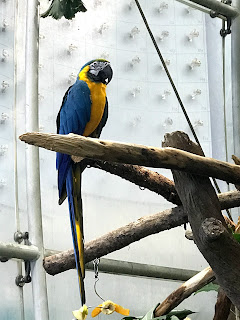Day trip to the California Academy of Sciences
Many years ago, Daddy often brought Anna, Biboy, and me to museums in Manila while Mommy was shopping in Divisoria. Oftentimes, the highlights of our educational trips were not the exhibits; instead, they could be the train ride to the museum or the automatic glass door.
Anyway, flash forward to 2020. Biboy and Barbara appear to want to start Gabriel's educational adventure pretty young, following what we've experienced as kids. So one Saturday, we trooped to the California Academy of Sciences.
Gabriel's attention was mostly captured by the big animals moving inside their aquariums. He had a grand time saying hi to the fish and the penguins. Because they're all on the other side of the glass, he kept tapping on the glass and calling them "Balbon", the name of their dog.
For older kids (including me when I first dropped by), one of the whoa! moments is seeing this skeleton of the Tyrannosaurus rex towering over the academy's lobby for the first time. But for the wee one, he didn't even look up! Understandable, because the skeleton wasn't moving.
Nearby was the African exhibit. Each time I visit it, I am amazed at how big the animals in the African wilderness are. For instance, I always thought that antelope are just a bit bigger than goats. But the exhibits suggest that they are much larger than I thought. And the zebras are stockier than regular horses.
The penguin area was a big hit, as always, to kids and their parents. I've seen them before so I opted to stay in the back of the crowd and to talk with the docent... she allowed me to hold a weighted stuffed penguin doll to give me an idea of how heavy one penguin could be (and they're HEAVY!)
There were other live animals in the academy too. We saw macaws hanging out in the canopy inside the rainforest and geckoes inside a glass cage. There were numerous butterflies feeding on fruit set out near pathways, and nudibranchs were lazily floating about in one aquarium.
In the swamp exhibit, we saw the albino alligator lounging underwater with a giant turtle. Nothing much to see because they were just relaxing there. There weren't any fish with them.
It was another good day to be in the museum. Biboy, Barbara, and Gabriel went home ahead of us. But we wanted to completely tour the academy so we hung back and visited the rooftop garden, the earthquake simulator, and the fog machine. We also watched a movie about the universe in the academy's planetarium. But the highlight of our day there, for me, was touching the plasma ball at the souvenir shop.












Comments
Post a Comment
Thank you for dropping by!
Before moving on, please share your thoughts or comments about the post. :)
Thanks again!